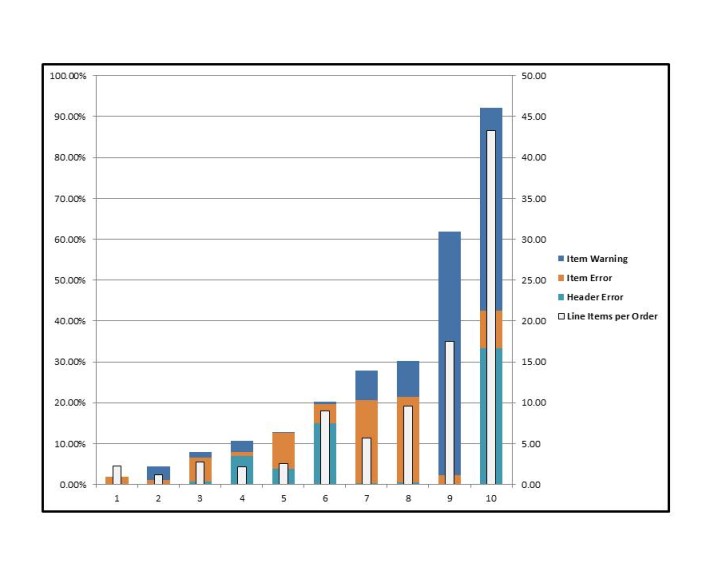Share
Author
Sam Bayer
Share
Well-Formed Orders in SAP eCommerce
In my previous post entitled “Secrets to Successful B2B Order Processing? Three F’s.” I suggested that the approach to producing well-formed SAP® B2B orders was to make the “Fail and Fix” loops go Faster. Acknowledge that exceptions will occur (our data suggests that 27% of orders, on average, will produce exceptions) and minimize the time required to notify the customer and resolve the issues.
Today’s post will dig a little deeper into the prevalence of Exceptions in these orders, get a better understanding of their root causes, and make several suggestions to improve the situation.
Collecting the Data
We mined the Corevist SAP® Integrated B2B eCommerce website transaction logs for a subset (10) of our clients, and their customers, for the entire month of April 2014. You can consider these transaction logs, normally used for technical support purposes, as a detailed audit trail of every website user’s experience. What selection they made, what data they entered, what result they received during every one of their website sessions. After excluding our clients’ employees (salespeople and CSRs) who used the website, we were left with a sample of 50,000+ customers who placed ~ 25,000 orders, with ~130,000 line items, into SAP® in real time.
The Clients selected are representatives of all of the B2B Business Models and Personas that the Corevist platform supports. That ranges from sales to Distributors, Dealers, and Corporate Accounts as well as Inter-Company transfers. It also supports everyone from Power Users, who upload spreadsheet based seasonal and repeat orders, to the Casual website user who starts their buying experience by browsing a catalog.
For each client, we counted and analyzed all of the Exceptions that their customers experienced during their B2B eCommerce website sessions. Exceptions come in two flavors, “hard errors” and “warnings” that can occur at both the order header level and item level. A “hard error” is a business rule that will not let the user proceed until it is fixed (missing or duplicate PO number, requested delivery date is not allowed, item not found, Shipto not found etc.). “Warnings” are provided to the user for informational purposes (an item has been substituted, a quantity has been rounded to the minimum order quantity etc.) and don’t require the user to intervene. Warnings may simply provide the user with information about how the data they entered has been changed, thereby enabling their orders to become “processable” by the Supplier’s SAP® system.
Observations
Not unexpectedly, our first attempt to analyze the data has produced more questions than answers. (Such is the fate of all researchers in the burgeoning “Big Data” field). Nevertheless, by examining the attached graphic, we can make the following observations with certainty:
1. 100% of our Clients had orders with Exceptions. There are no exceptions to these Exceptions. Everyone has to deal with orders that trigger errors or warnings.
2. 27% of Orders triggered Exceptions – The “average” B2B client in our study processed 2,462 orders that contained 5.23 line items in the month of April. Exceptions were found in 27% of those orders.
3. There is a large variability in Exception rates – Across our Client base, the total exceptions varied from an enviable 1.92% to an abysmal 92.2%.
4. The larger the order the greater the chance for Exceptions – It stands to reason that larger orders should produce a larger absolute number of Exceptions. However, the data suggests with a high degree of correlation (r=0.98), that larger orders produce a larger percentage of Exceptions. That means that sales to Distributors (generally orders with >5 line items) are especially vulnerable to Exceptions.
5. Each client has a different Exception “fingerprint” – Some have a large number of Item Warnings (part number substitutions) (Clients #9 and #10) while some have a large number of Item Errors (parts not found) (Clients #7 and #8). Some have a greater percentage of order preventing Header Errors (Client #4 has a few customers with significant credit issues and Client #6 is not only dealing with credit issues but has many customers who are attempting to get order discounts using bogus promotion codes.)
Discussion
There is bad news and good news demonstrated by this exercise.
The bad news is that Exceptions do indeed litter the road to a complete SAP® B2B Order. That’s not new news to anyone that has to process EDI, Fax and email orders.
The good news is that our SAP® Integrated B2B eCommerce website has demonstrated itself to be a very effective tool in empowering end-users to fix their own orders in real time. In fact, in the month of April, website users across the sampled Corevist client base, successfully dealt with 34,786 of these Exceptions all by themselves. To be sure many of those Exceptions were simply informational and required no user intervention, but many of those Exceptions did instigate action on the part of the user. The great news is that those later Exceptions were all dealt with in real time! That means website customers had zero delays in the process of placing a fulfill-able order. Compare that to the hours or days it might take to resolve issues with those orders manually.
So what’s next?
Here are a few ideas:
1. Reduce Exceptions – We should provide our Clients with periodic reports that do a root cause analysis of all website Exceptions and guide them in dealing with them according to the Pareto Principle priorities. 80% of the Exceptions are triggered by 20% of the Item/Header warnings/errors. Ostensibly, this should also improve the throughput of EDI/Fax orders.
2. Extend the Corevist solution to enable the fixing of EDI/Fax orders – Feedback from some of our clients, and prospective clients, leads us to believe that trapping errant EDI and Faxed orders and shepherding their submitters to our website for self-service fixing of those orders would provide great value to all parties. I’ll know that that is a real requirement as soon as someone is willing to pay for it :-).
3. Online Chat triggered by Exceptions – I’ve become a believer in the judicious use of online chat facilities and think I’ve found a “killer” use case for it. We have always been able to sense when a website user trips an Exception in the order creation process. I would think it would be of great value for Salespeople or CSRs to be given an opportunity to come to the aid of their customers “just in time”. This is a perfect use for Online Chat. Customer gets a “Material id not found” Exception and a friendly operator injects themselves into an Online Chat conversation by saying “Sorry, that product is no longer available via the web but maybe this one could do the trick?”.
4. Smarter product searching – The vast majority of Item Errors are of the “material id not found” variety. That’s typically because website users are typing in incorrect numbers. Anything that can be used to assist in that process will lower the Exception rate of your orders. Half of our B2B clients have implemented Magento catalogs which have added significant value. Having customers select from “recently ordered products” should also reduce Item Errors significantly. Lastly, providing a “type ahead” feature in the query input field should also reduce Item Errors significantly.
Summary
Time is money.
Any delay inserted into the Order Creation process is prolonging your ability to ship, and invoice for, that product. The question facing Manufacturers today is do they believe that their customers have that shared goal? Do customers want to know in real time what’s wrong with their orders and be given the opportunity to fix them? (Don’t forget, on average, 27% of B2B Orders have Exceptions.) Or, would they prefer to send them to you in the blind and play the odds that they’ll go through in a timely fashion?
Our experience in the B2B world is that relationships between Suppliers and their Customers are indeed partnerships. In a partnership, people work together towards a common goal. Getting product out the door in a timely, and cost effective fashion, is important to both parties. The first step in that process is an accurate order.
We know we can produce 100% accurate orders in real time on our SAP® Integrated websites. We now believe that we can reduce the time it takes to fix EDI/Fax orders to real time as well.
This could change everything.
Sam









